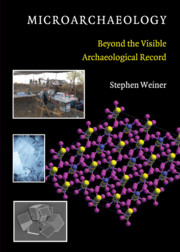Book contents
- Frontmatter
- Contents
- Preface
- 1 Archaeology, Archaeological Science, and Microarchaeology
- 2 Information Embedded in the Microscopic Record
- 3 Completeness of the Archaeological Record
- 4 Common Mineral Components of the Archaeological Record
- 5 Biological Materials: Bones and Teeth
- 6 Biological Materials: Phytoliths, Diatoms, Eggshells, Otoliths, and Mollusk Shells
- 7 Reconstructing Pyrotechnological Processes
- 8 Biological Molecules and Macromolecules: Protected Niches
- 9 Ethnoarchaeology of the Microscopic Record: Learning from the Present
- 10 Absolute Dating: Assessing the Quality of a Date
- 11 Reading the Microscopic Record On-Site
- 12 Infrared Spectroscopy in Archaeology
- Appendix A Identifying Minerals Using Microchemical Analysis
- Appendix B Identifying Minerals and Compounds Using Infrared Spectra: Table of Standard Minerals and Compounds for Which Infrared Spectra Are Available
- References
- Index
- Plates section
11 - Reading the Microscopic Record On-Site
Published online by Cambridge University Press: 05 June 2012
- Frontmatter
- Contents
- Preface
- 1 Archaeology, Archaeological Science, and Microarchaeology
- 2 Information Embedded in the Microscopic Record
- 3 Completeness of the Archaeological Record
- 4 Common Mineral Components of the Archaeological Record
- 5 Biological Materials: Bones and Teeth
- 6 Biological Materials: Phytoliths, Diatoms, Eggshells, Otoliths, and Mollusk Shells
- 7 Reconstructing Pyrotechnological Processes
- 8 Biological Molecules and Macromolecules: Protected Niches
- 9 Ethnoarchaeology of the Microscopic Record: Learning from the Present
- 10 Absolute Dating: Assessing the Quality of a Date
- 11 Reading the Microscopic Record On-Site
- 12 Infrared Spectroscopy in Archaeology
- Appendix A Identifying Minerals Using Microchemical Analysis
- Appendix B Identifying Minerals and Compounds Using Infrared Spectra: Table of Standard Minerals and Compounds for Which Infrared Spectra Are Available
- References
- Index
- Plates section
Summary
The division of the archaeological record into the microscopic and macroscopic records is based only on the fact that instrumentation is necessary to read the microscopic record. In reality, both are part of the same entity, and as such, they should ideally be exposed and investigated in an integrated manner. A very helpful approach for partially achieving this goal is to obtain some data on the microscopic record on-site during the excavation.
BENEFITS OF AN ON-SITE INTERACTIVE LABORATORY
Some benefits of an on-site laboratory follow:
The key element in this concept is that the results of the analyses obtained on-site are immediately integrated into the overall effort to better understand the significance of the excavation under way. This necessitates that the work on-site adopt an interactive problem-solving mode that provides answers in minutes, hours, or at most, from one day to the next. The ideal mode of operation of the on-site laboratory is to define a specific question, take a few samples that can address this question, and analyze them immediately. With the results in hand, the question can be refined or rejected. The next round of sampling can then be based on the new information. In this way, ideas can be efficiently tested, and if they appear to be well based, a full and effective sample set can be obtained for analysis off-site. This sample set will be better able to validate or negate an hypothesis, as compared to a sample set collected “blind.”
The process of excavation is irreversible and destructive. It is therefore invaluable to have information available in “real time” so that the mode of excavation can be adjusted to the nature of the materials being exposed.
[…]
- Type
- Chapter
- Information
- MicroarchaeologyBeyond the Visible Archaeological Record, pp. 261 - 274Publisher: Cambridge University PressPrint publication year: 2010



